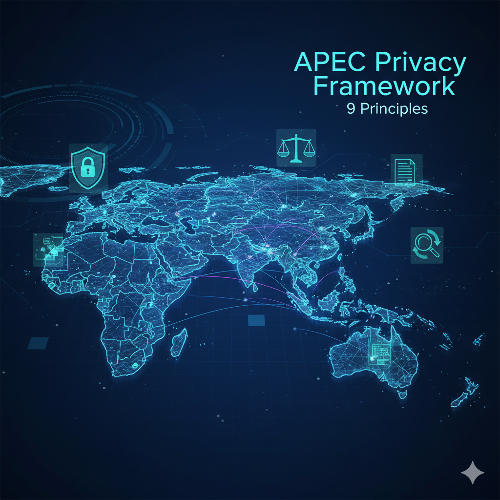Understanding the 9 APEC Privacy Framework Principles: A Guide for Global Organisations in Asia
Navigating Asia-Pacific Data Flows: An Introduction
For global organisations, the Asia-Pacific (APAC) region represents immense opportunity, but it also presents a complex and fragmented data privacy landscape. Unlike the European Union's unified GDPR, the APAC region consists of numerous economies, each with its own sovereignty, culture, and data protection laws.
This is where the Asia-Pacific Economic Cooperation (APEC) Privacy Framework becomes a critical strategic tool.
Established to build trust and facilitate the free flow of information—the lifeblood of the digital economy—the APEC Framework provides a set of common principles for data protection. For global companies, understanding and aligning with this framework is not just a compliance exercise; it's a key enabler for cross-border data transfers and a powerful way to build consumer trust across the region.
At Formiti Data International, we believe that robust data governance is a competitive advantage. This article provides an in-depth guide to the 9 APEC Privacy Principles and the practical, enforceable system built upon them: the Cross-Border Privacy Rules (CBPR) System.
? What is the APEC Privacy Framework?
First, a crucial distinction:
- The APEC Privacy Framework (2015): This is a set of non-binding, high-level principles agreed upon by the 21 APEC member economies. It's a "common language" for privacy, designed to be flexible and interoperable with different national laws.
- The APEC Cross-Border Privacy Rules (CBPR) System: This is the voluntary, enforceable, accountability-based system that implements the Framework. Organisations can get certified as CBPR-compliant, which demonstrates their data privacy practices are in line with APEC standards.
Think of the Framework as the rulebook and the CBPR System as the certification program that proves you follow the rules. This certification is what facilitates data transfers between participating member economies.
⚖️ The 9 APEC Privacy Principles: An In-Depth Breakdown
The entire APEC Framework is built upon nine core principles. Here is a detailed look at each one and what it means for your business.
1. Preventing Harm
This is the foundational principle. All other principles are designed to support this one goal.
- The Principle: Organisations should implement privacy protections proportional to the likelihood and severity of harm (e.g., financial loss, reputational damage, discrimination) that could result from the misuse of personal information.
- What This Means for Your Business: Your data privacy program must be risk-based. You must actively conduct Data Protection Impact Assessments (DPIAs) or similar privacy risk assessments before collecting or using personal data in new ways.
2. Notice
This principle is all about transparency.
- The Principle: Individuals must be provided with clear, conspicuous, and timely notice about how their personal information is collected, used, and disclosed.
- What This Means for Your Business: Your privacy notices must be easy to find, easy to understand (no legal jargon), and accurate. This includes informing users about third-party sharing and any cross-border data transfers.
3. Collection Limitation
This is the essence of data minimisation.
- The Principle: The collection of personal information should be limited to what is relevant, necessary, and directly related to the purposes specified in the "Notice." Data should be obtained by lawful and fair means.
- What This Means for Your Business: Stop collecting data "just in case." Every data field on your forms and in your systems must be justified by a specific, legitimate business purpose.
4. Use of Personal Information (Purpose Limitation)
This principle ensures data isn't used in unexpected or harmful ways.
- The Principle: Personal information should only be used or disclosed for the purposes specified in the "Notice" (or for compatible purposes). For any new use, you must obtain fresh consent or have another legitimate basis.
- What This Means for Your Business: This directly impacts marketing, analytics, and AI model training. You cannot simply repurpose customer data for a new project without assessing if it's compatible with the original purpose for which it was collected.
5. Choice
This principle empowers the individual.
- The Principle: Individuals should be provided with mechanisms to exercise choice over the collection, use, and disclosure of their personal information. This is typically, but not always, "opt-in" or "opt-out" consent.
- What This Means for Your Business: You must provide clear and accessible mechanisms for individuals to manage their preferences (e.g., a "cookie consent" banner, an "unsubscribe" link, a privacy dashboard).
6. Integrity of Personal Information
Data is only valuable if it's correct.
- The Principle: Organisations must take reasonable steps to ensure that personal information is accurate, complete, and up-to-date, especially if it's used to make decisions that affect the individual (e.g., a credit check or job application).
- What This Means for Your Business: You need processes for data validation at the point of collection and a system for periodic data hygiene to correct or delete outdated information.
7. Security Safeguards
This is the core of data protection.
- The Principle: Personal information must be protected by appropriate technical, organisational, and physical security safeguards against risks like loss, unauthorised access, destruction, or disclosure.
- What This Means for Your Business: This goes beyond firewalls. It includes encryption (at rest and in transit), access controls, employee training, incident response plans, and robust vendor security assessments.
8. Access and Correction
This principle upholds individual rights.
- The Principle: Individuals should have the right to request access to their personal information and, where it's inaccurate, to challenge and correct it.
- What This Means for Your Business: You must have a clear and efficient process for handling Data Subject Access Requests (DSARs). This requires knowing what data you hold, where it is, and how to extract or amend it.
9. Accountability
This is the principle that holds the entire framework together.
- The Principle: An organisation is accountable for complying with all the principles above. It must be able to demonstrate compliance to regulators, partners, and individuals.
- What This Means for Your Business: This is the "show, don't tell" principle. It requires internal audits, record-keeping (like a Record of Processing Activities or RoPA), appointing a Data Protection Officer or privacy lead, and, crucially, being able to prove your compliance through the CBPR certification.
? From Principles to Practice: The APEC CBPR System
Understanding the 9 principles is the first step. The second is putting them into action through the APEC Cross-Border Privacy Rules (CBPR) System.
Why the CBPR System is a Game-Changer
For a global company, the CBPR system is a powerful tool. Here's why:
- It's an "Accountability-Based" Transfer Mechanism: Unlike GDPR, which often relies on strict "adequacy decisions," the CBPR system allows data to flow between certified companies in any participating APEC economy. It's a "data passport" that shows you are a trusted steward of information.
- It Simplifies Compliance: Instead of managing 20+ different sets of national laws, CBPR certification provides a single, high-level standard that demonstrates your commitment to privacy across the region.
- It Builds Trust: A CBPR certification is a verifiable, public-facing seal of approval. It tells customers and partners that your privacy program has been vetted by an independent, APEC-recognised Accountability Agent.
- It's Evolving: The APEC CBPR system is the foundation for the new Global CBPR Forum, which aims to extend this interoperable framework to countries outside of APEC, creating a truly global standard.
How do you get CBPR Certified?
The process involves applying to an APEC-recognised Accountability Agent. This third-party organisation will:
- Assess: Conduct a thorough review of your organisation's privacy policies and practices against the 50-point CBPR criteria (which are based on the 9 principles).
- Remediate: Work with you to identify and fix any gaps in your compliance.
- Certify: Once you meet the requirements, the Accountability Agent will grant you the CBPR certification.
- Enforce: This certification is binding. The Accountability Agent and your home economy's data protection authority (like the FTC in the US) can enforce compliance.
Note for Vendors: If your company acts as a data processor (e.g., a SaaS platform or cloud provider), there is a parallel certification called the Privacy Recognition for Processors (PRP) System designed specifically for you.
❓ Q&A for Global Data Leaders
We've compiled the most common questions our clients at Formiti ask about the APEC Framework.
Q1: Is the APEC Privacy Framework legally binding?
A: No. The Framework itself is a set of non-binding principles. However, the APEC CBPR System is a voluntary certification that becomes enforceable against participating companies by government regulators (like the FTC in the US or Japan's PPC) through the Cross-border Privacy Enforcement Arrangement (CPEA).
Q2: How is the APEC Framework different from GDPR?
A: They are more similar than different (both are based on FIPs), but the key difference is in data transfers.
- GDPR relies on strict adequacy decisions, Standard Contractual Clauses (SCCs), or Binding Corporate Rules (BCRs) to transfer data outside the EU.
- APEC's CBPR uses an "accountability" model. It allows data to flow between certified organisations in any participating economy, acting as a regional data transfer mechanism. It is often seen as more flexible and business-friendly in its approach.
Q3: What are the APEC CBPR 9 Principles? The nine principles are:
- Preventing Harm
- Notice
- Collection Limitation
- Use of Personal Information
- Choice
- Integrity of Personal Information
- Security Safeguards
- Access and Correction
- Accountability
Q4: My company is already GDPR compliant. Does that mean I'm APEC compliant?
A: Not automatically, but you are in an excellent position. Your existing GDPR program (like your RoPA, DPIA process, and security measures) covers most of what the APEC principles require. The main work will be a "gap analysis" to map your existing controls to the 50 CBPR requirements and align your cross-border data transfer strategy with the CBPR model.
Don't let data compliance be a barrier to your growth in Asia. Use it as an advantage.
Would you like to schedule a consultation to discuss your organisation's APEC CBPR readiness? Click here

